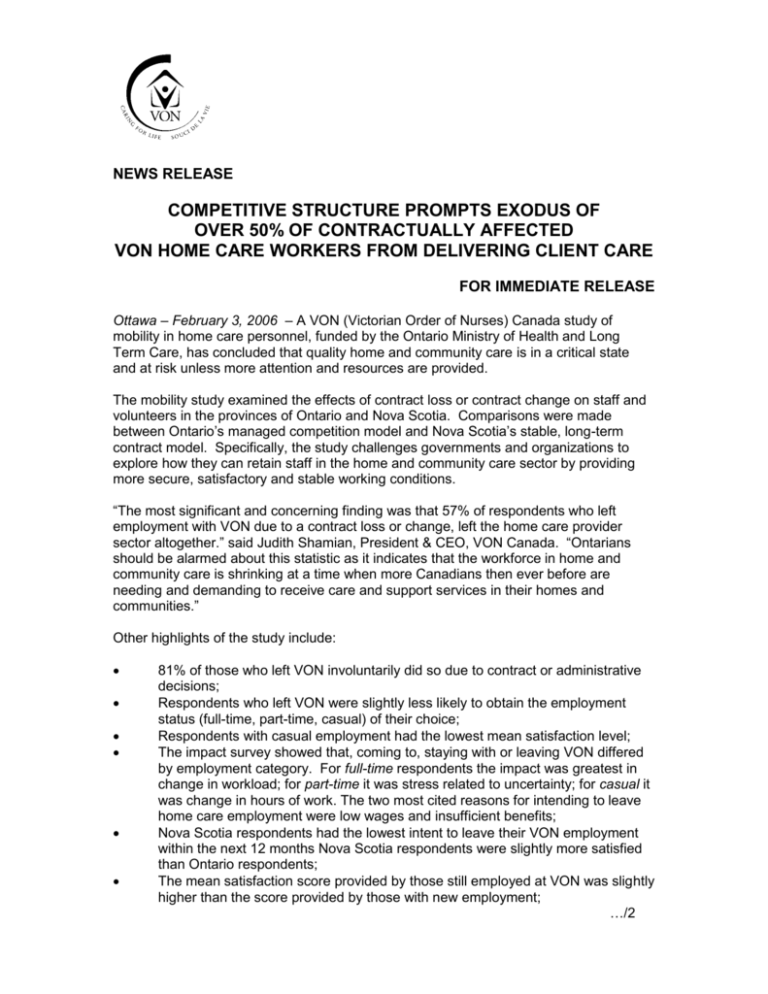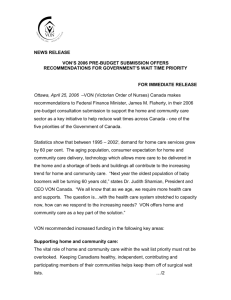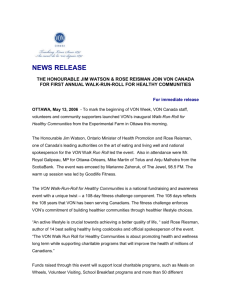Competitive Structure Prompts Exodus of Over 50
advertisement

NEWS RELEASE COMPETITIVE STRUCTURE PROMPTS EXODUS OF OVER 50% OF CONTRACTUALLY AFFECTED VON HOME CARE WORKERS FROM DELIVERING CLIENT CARE FOR IMMEDIATE RELEASE Ottawa – February 3, 2006 – A VON (Victorian Order of Nurses) Canada study of mobility in home care personnel, funded by the Ontario Ministry of Health and Long Term Care, has concluded that quality home and community care is in a critical state and at risk unless more attention and resources are provided. The mobility study examined the effects of contract loss or contract change on staff and volunteers in the provinces of Ontario and Nova Scotia. Comparisons were made between Ontario’s managed competition model and Nova Scotia’s stable, long-term contract model. Specifically, the study challenges governments and organizations to explore how they can retain staff in the home and community care sector by providing more secure, satisfactory and stable working conditions. “The most significant and concerning finding was that 57% of respondents who left employment with VON due to a contract loss or change, left the home care provider sector altogether.” said Judith Shamian, President & CEO, VON Canada. “Ontarians should be alarmed about this statistic as it indicates that the workforce in home and community care is shrinking at a time when more Canadians then ever before are needing and demanding to receive care and support services in their homes and communities.” Other highlights of the study include: 81% of those who left VON involuntarily did so due to contract or administrative decisions; Respondents who left VON were slightly less likely to obtain the employment status (full-time, part-time, casual) of their choice; Respondents with casual employment had the lowest mean satisfaction level; The impact survey showed that, coming to, staying with or leaving VON differed by employment category. For full-time respondents the impact was greatest in change in workload; for part-time it was stress related to uncertainty; for casual it was change in hours of work. The two most cited reasons for intending to leave home care employment were low wages and insufficient benefits; Nova Scotia respondents had the lowest intent to leave their VON employment within the next 12 months Nova Scotia respondents were slightly more satisfied than Ontario respondents; The mean satisfaction score provided by those still employed at VON was slightly higher than the score provided by those with new employment; …/2 2– The highest impact for clerical workers and for managers was stress related to change in established ties and friendships; and Ontario respondents had a statistically significant higher impact score than did Nova Scotia for: need to find a job, need to update a resume, need to undergo an interview, loss of income, change in salary and stress related to change in established ties and friendships. In 2004 the First Ministers agreed to recognize home care as a priority and provide short-term acute home care, short-term acute community mental health home care and end-of-life care by 2006. “Although every province and territory has established a home care program and investments in home care have been steadily rising, the mobility study indicates that severe shortage of staff in the home and community sector is inevitable unless immediate efforts are made to sustain and build the workforce in this sector.” said Shamian. The demand for home and community care services is growing exponentially as the population ages and Canadians prefer to receive care and support services in their own homes and communities. Statistics show that from 1995 – 2000, demand for home and community care grew by 140%. To ensure that the home and community care sector can appropriately respond, improvements must be made in the structure and administration of home care. In its submission to the Honourable Elinor Caplan, to which Minister Smitherman is expected to respond soon, the VON called on the government to make the following changes in the area of health human resources to stabilize the sector: The request for proposal (RFP) process should recognize the value of providers that have existing skilled human resources in the local community; The RFP process should score the human resource element at a level similar to that for quality in order to recognize that excellence in client care depends on excellence in human resources; The client assessment function should be performed by the providers rather than by the CCAC Case Managers to avoid redundant use of limited resources; and, That the RFP process weigh paid orientation and ongoing training in the revised scoring system. For more information on the VON Mobility Study and VON Canada’s submission to the Honourable Elinor Caplan, please visit www.von.ca. VON is dedicated to being a leader in the delivery of innovative comprehensive health and social services and to influencing the development of health and social policy in Canada. We are a national health organization and registered charity offering a wide range of community health care solutions that meet the needs of Canadians from coast to coast. VON is committed to continuous quality improvement and is accredited by the Canadian Council of Health Services Accreditation. -30Media inquiries: Jennifer Stevens Communications Manager VON Canada 613-296-9736








